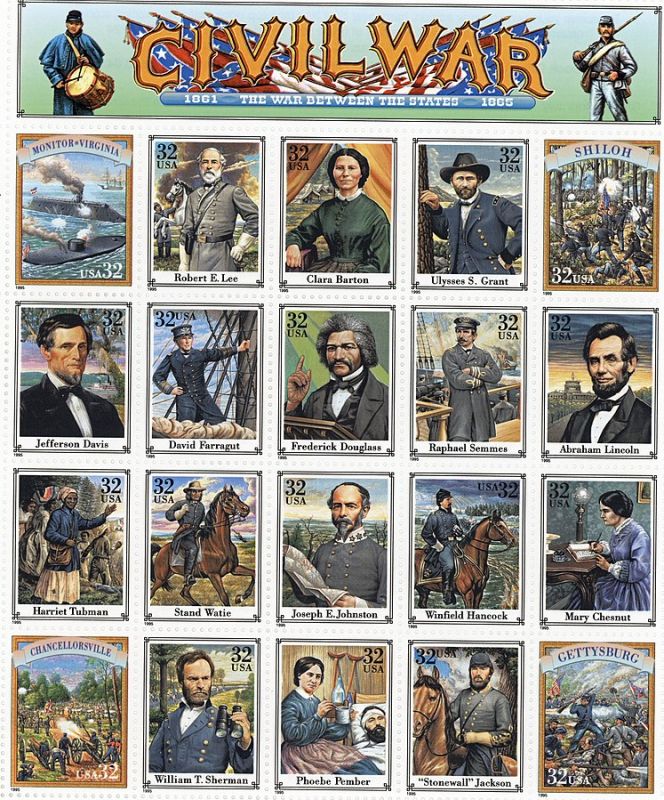Civil War Era News Stories and Recruitment Advertisements
In an interview with Ken Burns, the historian Stephen B. Oates called the Civil War the "great central experience" of United States history (1989, para 14). The Declaration of Independence and the United States Constitution promised liberty and justice for all, but Black slavery in southern states contradicted and undermined those values and questioned the survival of democracy as a form government.
In many ways, the Civil War is still with us as a nation today. Black Americans still seek equality under the law. Racism toward Black people still permeates through all aspects of society. Conservative white politicians in red states seek to limit the political participation and voting of people of color. In 1968, the Kerner Commission declared "Our nation is moving toward two societies, one black, one white - separate and unequal" (para. 2). That reality remains true in the third decade of the 21st century.

Activity 1: Read Stories Across State Lines
The 2018 Massachusetts History and Social Science Curriculum Framework lists the following critical policies and events leading to the Civil War:
- The Missouri Compromise (1831-1832)
- South Carolina Nullification Crisis (1832-1833)
- Wilmot Proviso (1846)
- The Mexican-American War (1846-1848)
- Compromise of 1850
- Publication of Harriet Beecher Stowe’s Uncle Tom’s Cabin (1851-1852)
- Kansas-Nebraska Act (1854)
- The Supreme Court decision in Dred Scott v. Sanford (1857)
- Lincoln-Douglas debates (1858)
- John Brown’s raid on Harper’s Ferry (1859)
- Election of Abraham Lincoln (1860)
Select one of these events/policies and find two original news articles - one published in Northern territory and one published in Southern territory about it.
- Use the Teacher and Student Guide to Analyzing News & Newspapers to critically evaluate each publication.
- Create a screen recording or interactive image to present your findings.
- Interactive image:
- Start a new Google Drawings canvas.
- Upload a screenshot of the newspaper article to the middle of the canvas.
- Insert text boxes and shapes to call attention to your findings.
- Add links to additional information (e.g., the original image source).
- Screen recording:
- If you have a Mac computer, use this shortcut.
- If you have access to Quicktime, here's how to screen record using Quicktime.
- Otherwise, use a web-based screen recording tool such as Screencastify, Screencast-o-Matic, or Loom.
- Interactive image:
Designing for Learning: Student-Created Activity Example
Read Stories Across State Lines by Rianna Jakson, Ryan Hunt, Lisbel VargasActivity 2: Examine Recruitment Advertisements
- Review the following advertisements intended to recruit soldiers for the Civil War:
- What are commonly used terms or words to recruit soldiers? Why do you think those words were used?
- How did the advertisers attempt to persuade men to enlist?
- How is the language different in advertisements for Black soldiers versus white soldiers? What about for the advertisements from the North versus the South? Why do you think that is?
- Design a modern-day advertisement, using TikTok or Snapchat, to persuade individuals to enlist in the Civil War.
Designing for Learning: Student-Created Activity Example
Civil War Era News Stories and Recruitment Ads by Sean BarberaAdditional Resources
- Policies and Events Leading to the Civil War, resourcesforhistoryteachers wiki
- The Civil War: The Nation Moves Towards War, 1850-61, Library of Congress
Connecting to the Building Democracy for All eBook
Building Democracy for All: Harriet Tubman, William Still, and the Underground Railroad
Connecting to the Standards
- Massachusetts Civics & Government Standards
- Analyze the Constitutional issues that caused the Civil War and led to the eventual expansion of the power of the federal government and individual civil rights. (Massachusetts Curriculum Framework for History and Social Studies) [8.T5.3]
- ISTE Standards
- Digital Citizen
- 2c: Students demonstrate an understanding of and respect for the rights and obligations of using and sharing intellectual property.
- Knowledge Constructor
- 3a: Students plan and employ effective research strategies to locate information and other resources for their intellectual or creative pursuits.
- 3b: Students evaluate the accuracy, perspective, credibility and relevance of information, media, data, or other resources.
- Creative Communicator
- 6a: Students choose the appropriate platforms and tools for meeting the desired objectives of their creation or communication.
- 6b: Students create original works or responsibly repurpose or remix digital resources into new creations.
- 6d: Students publish or present content that customizes the message and medium for the intended audiences.
- Digital Citizen
- DLCS Standards
- Ethics and Laws (CAS.b)
- Interpersonal and Societal Impact (CAS.c)
- Digital Tools (DTC.a)
- Collaboration and Communication (DTC.b)
- Research (DTC.c)
- English Language Arts > History/Social Studies Common Core Standards
- CCSS.ELA-LITERACY.RH.6-8.1
- CCSS.ELA-LITERACY.RH.6-8.2
- CCSS.ELA-LITERACY.RH.6-8.5
- CCSS.ELA-LITERACY.RH.6-8.6
- CCSS.ELA-LITERACY.RH.6-8.7
- CCSS.ELA-LITERACY.RH.6-8.8
- CCSS.ELA-LITERACY.RH.9-10.1
- CCSS.ELA-LITERACY.RH.9-10.2
- CCSS.ELA-LITERACY.RH.9-10.5
- CCSS.ELA-LITERACY.RH.9-10.6
- CCSS.ELA-LITERACY.RH.9-10.9
- CCSS.ELA-LITERACY.RH.11-12.1
- CCSS.ELA-LITERACY.RH.11-12.2
- CCSS.ELA-LITERACY.RH.11-12.3
- CCSS.ELA-LITERACY.RH.11-12.6
- CCSS.ELA-LITERACY.RH.11-12.7
- CCSS.ELA-LITERACY.RH.11-12.8